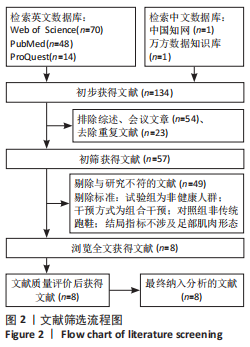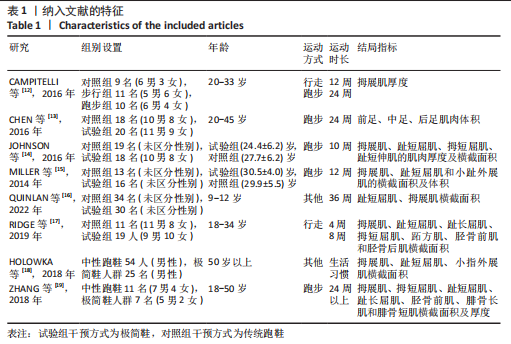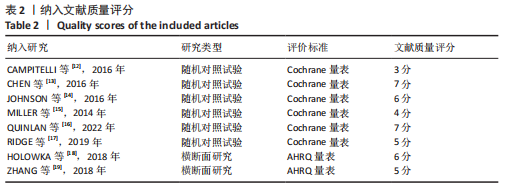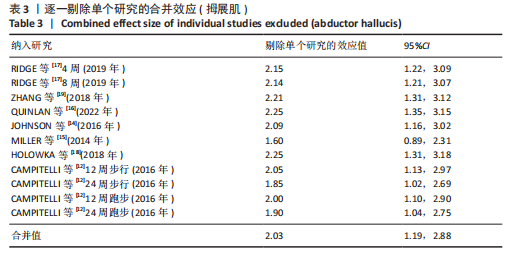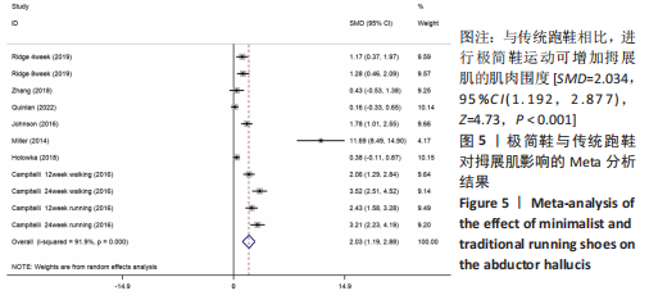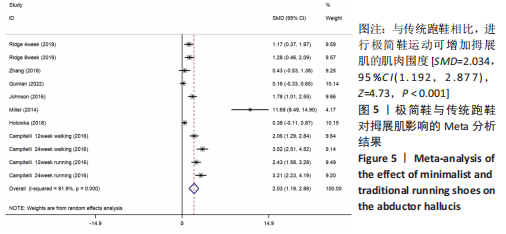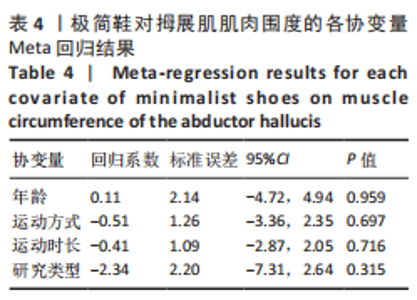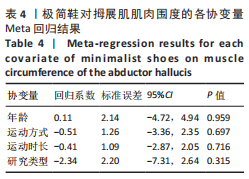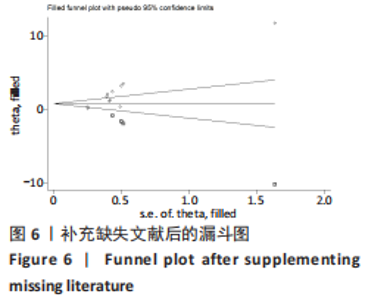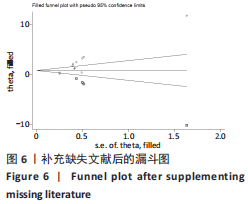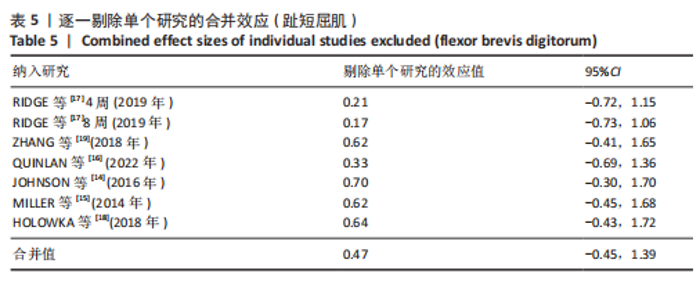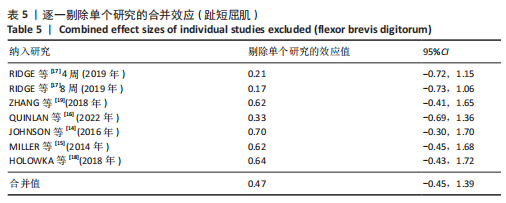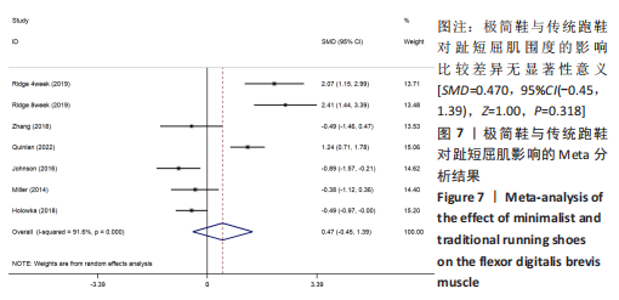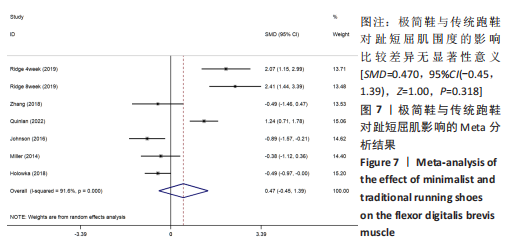Chinese Journal of Tissue Engineering Research ›› 2024, Vol. 28 ›› Issue (4): 646-650.doi: 10.12307/2024.232
Previous Articles Next Articles
Effect of minimalist shoes on foot muscle morphology: systematic evaluation and Meta-analysis
Bai Xiaotian1, Chen Zhaoying2, Song Yiling1, Wang Ye1, Liu Jingmin1
- 1Department of Physical Education, Tsinghua University, Beijing 100084, China; 2The Third Hospital of Hebei Medical University, Shijiazhuang 050051, Hebei Province, China
-
Received:2023-01-11Accepted:2023-02-18Online:2024-02-08Published:2023-07-14 -
Contact:Liu Jingmin, Professor, Department of Physical Education, Tsinghua University, Beijing 100084, China -
About author:Bai Xiaotian, PhD candidate, Department of Physical Education, Tsinghua University, Beijing 100084, China -
Supported by:Tsinghua University Independent Research Project, No. 2021THZWJC15 (to WY)
CLC Number:
Cite this article
Bai Xiaotian, Chen Zhaoying, Song Yiling, Wang Ye, Liu Jingmin. Effect of minimalist shoes on foot muscle morphology: systematic evaluation and Meta-analysis[J]. Chinese Journal of Tissue Engineering Research, 2024, 28(4): 646-650.
share this article
Add to citation manager EndNote|Reference Manager|ProCite|BibTeX|RefWorks
| [1] BARTON CJ, BONANNO D, MENZ HB. Development and evaluation of a tool for the assessment of footwear characteristics. J Foot Ankle Res. 2009;2:10. [2] 肖松林,张希妮,孙晓乐,等.基于足核心系统的足部功能增强研究进展[J].中国康复理论与实践,2020,26(10):1186-1192. [3] VAN DER WORP MP, TEN HAAF DS, VAN CINGEL R, et al. Injuries in runners: a systematic review on risk factors and sex differences. PLoS One. 2015;10(2):e114937. [4] BOWSER BJ, ROSE WC, MCGRATH R, et al. Effect of Footwear on Dynamic Stability during Single-leg Jump Landings. Int J Sports Med. 2017;38(6):481-486. [5] MCCARTHY C, FLEMING N, DONNE B, et al. 12 weeks of simulated barefoot running changes foot-strike patterns in female runners. Int J Sports Med. 2014;35(5):443-450. [6] SQUADRONE R, RODANO R, HAMILL J, et al. Acute effect of different minimalist shoes on foot strike pattern and kinematics in rearfoot strikers during running. J Sports Sci. 2015;33(11):1196-1204. [7] BAXTER JR, PIAZZA SJ. Plantar flexor moment arm and muscle volume predict torque-generating capacity in young men. J Appl Physiol. 2014;116(5):538-544. [8] KUSAGAWA Y, KURIHARA T, MAEO S, et al. Associations between the size of individual plantar intrinsic and extrinsic foot muscles and toe flexor strength. J Foot Ankle Res. 2022;15(1):22. [9] HIGGINS JPT GS. Cochrane Handbook for Systematic Reviews of Interventions 5.2.0..[2022-12-17] http://www.cochrane.org/resources/handbook/hbook.htm (accessed June 2017). [10] 侯筱,吕一帆,刘静民.肌肉电刺激力量训练影响运动者肌力的Meta分析[J].中国组织工程研究,2020,24(23):3764-3772. [11] 曾宪涛,刘慧,陈曦,等. Meta分析系列之四:观察性研究的质量评价工具[J].中国循证心血管医学杂志,2012,4(4):297-299. [12] CAMPITELLI NA, SPENCER SA, BERNHARD K, et al. Effect of Vibram FiveFingers Minimalist Shoes on the Abductor Hallucis Muscle. J Am Podiatr Med Assoc. 2016;106(5):344-351. [13] CHEN TL, SZE LK, DAVIS IS, et al. Effects of training in minimalist shoes on the intrinsic and extrinsic foot muscle volume. Clin Biomech (Bristol, Avon). 2016;36:8-13. [14] JOHNSON AW, MYRER JW, MITCHELL UH, et al. The Effects of a Transition to Minimalist Shoe Running on Intrinsic Foot Muscle Size. Int J Sports Med. 2016;37(2):154-158. [15] MILLER EE, WHITCOME KK, LIEBERMAN DE, et al. The effect of minimal shoes on arch structure and intrinsic foot muscle strength. J Sport Health Sci. 2014;3(2):74-85. [16] QUINLAN S, SINCLAIR P, HUNT A, et al. The long-term effects of wearing moderate minimalist shoes on a child’s foot strength, muscle structure and balance: A randomised controlled trial. Gait Posture. 2022;92:371-377. [17] RIDGE ST, OLSEN MT, BRUENING DA, et al. Walking in Minimalist Shoes Is Effective for Strengthening Foot Muscles. Med Sci Sports Exerc. 2019;51(1):104-113. [18] HOLOWKA NB, WALLACE IJ, LIEBERMAN DE. Foot strength and stiffness are related to footwear use in a comparison of minimally- vs. conventionally-shod populations. Sci Rep. 2018;8:1-12. [19] ZHANG X, DELABASTITA T, LISSENS J, et al. The morphology of foot soft tissues is associated with running shoe type in healthy recreational runners. J Sci Med Sport. 2018;21(7):686-690. [20] FREDERICKS W, SWANK S, TEISBERG M, et al. Lower extremity biomechanical relationships with different speeds in traditional, minimalist, and barefoot footwea. J Sports Sci Med. 2015; 14(2):276-283. [21] RICE HM, JAMISON ST, DAVIS IS. Footwear Matters: Influence of Footwear and Foot Strike on Load Rates during Running. Med Sci Sports Exerc. 2016;48(12):2462-2468. [22] 人体解剖学与组织胚胎学名词审定委员会.人体解剖学名词[M].北京:科学出版社,2014. [23] 许正勇,张先熠.足部内在肌形态的测量和与人体静态平衡稳定性的关系[J].体育学刊, 2016,23(2):133-137. [24] 罗林芬,邓群,陈立云,等.足底内侧和外侧群肌的肌内神经整体分布模式及临床意义[J].解剖学报,2021,52(2):264-269. [25] 詹姆斯·厄尔斯.行走的天性[M].北京:北京科学技术出版社,2018. [26] 张燊,张希妮,崔科东,等.足弓的运动功能进展及其在人体运动中的生物力学贡献[J].体育科学,2018,38(5):73-79. [27] KELLY LA, FARRIS DJ, CRESSWELL AG, et al. Intrinsic foot muscles contribute to elastic energy storage and return in the human foot. J Appl Physiol (1985). 2019;126(1):231-238. [28] BISHOP M, FIOLKOWSKI P, CONRAD B, et al. Athletic footwear, leg stiffness, and running kinematics. J Athl Train. 2006;41(4):387-392. [29] LIEBERMAN DE, VENKADESAN M, WERBEL WA, et al. Foot strike patterns and collision forces in habitually barefoot versus shod runners. Nature. 2010;463(7280):531-535. [30] 肖松林,孙晓乐,杨洋,等.跑鞋与触地模式的生物力学及其与损伤关系研究进展[J].应用力学学报,2022,39(2):201-208. |
| [1] | Zhang Zeyi, Yang Yimin, Li Wenyan, Zhang Meizhen. Effect of foot progression angle on lower extremity kinetics of knee osteoarthritis patients of different ages: a systematic review and meta-analysis [J]. Chinese Journal of Tissue Engineering Research, 2024, 28(6): 968-975. |
| [2] | Hu Zhixing, Li Qun, Yang Chao, Wang Xiaoxiao, Fang Luochangting, Hou Wuqiong, Lin Na, Chen Weiheng, Liu Chunfang, Lin Ya. Network meta-analysis of the modeling effects of different factors on rabbit models of steroid-induced osteonecrosis of femoral head [J]. Chinese Journal of Tissue Engineering Research, 2024, 28(6): 976-984. |
| [3] | Abuduwupuer·Haibier, Alimujiang·Yusufu, Maihemuti·Yakufu, Maimaitimin·Abulimiti, Tuerhongjiang·Abudurexiti. Meta-analysis of efficacy and safety of terlipatide and bisphosphate in the treatment of postmenopausal osteoporosis fractures [J]. Chinese Journal of Tissue Engineering Research, 2024, 28(4): 639-645. |
| [4] | Wang Juan, Wang Ling, Zuo Huiwu, Zheng Cheng, Wang Guanglan, Chen Peng. Rehabilitative efficacy of kinesio taping following anterior cruciate ligament reconstruction: a Meta-analysis [J]. Chinese Journal of Tissue Engineering Research, 2024, 28(4): 651-656. |
| [5] | Chang Wanpeng, Zhang Zhongwen, Yang Yulin, Zi Yang, Yang Mengqi, Du Bingyu, Wang Nan, Yu Shaohong. Efficacy of rehabilitation exoskeleton robots on post-stroke lower limb motor dysfunction: a Meta-analysis [J]. Chinese Journal of Tissue Engineering Research, 2024, 28(2): 321-328. |
| [6] | Wang Yanjin, Zhou Yingjie, Chai Xubin, Zhuo Hanjie. Meta-analysis of the efficacy and safety of 3D printed porous titanium alloy fusion cage in anterior cervical discectomy and fusion [J]. Chinese Journal of Tissue Engineering Research, 2023, 27(9): 1434-1440. |
| [7] | Jiang Xiaocheng, Shi Lu, Wang Yinbin, Li Qiujiang, Xi Chuangzhen, Ma Zefeng, Cai Lijun. Systematical evaluation of bone fusion rate after interbody fusion in patients with osteoporosis and lumbar degenerative disease treated with teriparatide [J]. Chinese Journal of Tissue Engineering Research, 2023, 27(9): 1427-1433. |
| [8] | Li Wenjie, You Aijia, Zhou Junli, Fang Sujuan, Li Chun. Effects of different dressings in the treatment of burn wounds: a network meta-analysis [J]. Chinese Journal of Tissue Engineering Research, 2023, 27(7): 1141-1148. |
| [9] | Chen Guanting, Zhang Linqi, Li Qingru. Meta-analysis of the value of exosomal miRNA for the diagnosis of chronic kidney disease [J]. Chinese Journal of Tissue Engineering Research, 2023, 27(6): 970-976. |
| [10] | Yan Le, Zhang Huiping, Dai Lintong. Mesenchymal stem cells for allergic rhinitis: a meta-analysis based on animal experiments [J]. Chinese Journal of Tissue Engineering Research, 2023, 27(6): 977-984. |
| [11] | Feng Liang, Gong Shuhui, Huo Hongfeng. Effect of short-foot training on foot and ankle function in patients with flat feet: Meta-analysis and systematic review [J]. Chinese Journal of Tissue Engineering Research, 2023, 27(5): 799-804. |
| [12] | Pan Weimin, Wang Bing, Han Yabing, Li Ting, Song Jiaqi, Qin Huasheng, Liu Yang. Effects of blood flow restriction training on muscle strength, muscle mass and physical performance in older adults: a Meta-analysis [J]. Chinese Journal of Tissue Engineering Research, 2023, 27(5): 805-812. |
| [13] | Yu Jiaan, Liu Xinwei, Lian Hongyu, Liu Kexin, Li Zitao. Medial open-wedge tibial osteotomy versus lateral closed-wedge tibial osteotomy for unicompartmental knee osteoarthritis: a meta-analysis [J]. Chinese Journal of Tissue Engineering Research, 2023, 27(4): 632-639. |
| [14] | Xu Yangyang, He Peiliang, Meng Qingqi, Li Siming. A meta-analysis of the effects of continuous adductor canal block and continuous femoral nerve block on early activity after knee arthroplasty [J]. Chinese Journal of Tissue Engineering Research, 2023, 27(4): 640-645. |
| [15] | Chai Hao, Yang Deyong, Zhang Lei, Shu Li. 3D printing personalized osteotomy guide technology versus conventional total knee arthroplasty on the accuracy of lower limb force alignment: a meta-analysis [J]. Chinese Journal of Tissue Engineering Research, 2023, 27(4): 646-654. |
| Viewed | ||||||
|
Full text |
|
|||||
|
Abstract |
|
|||||

